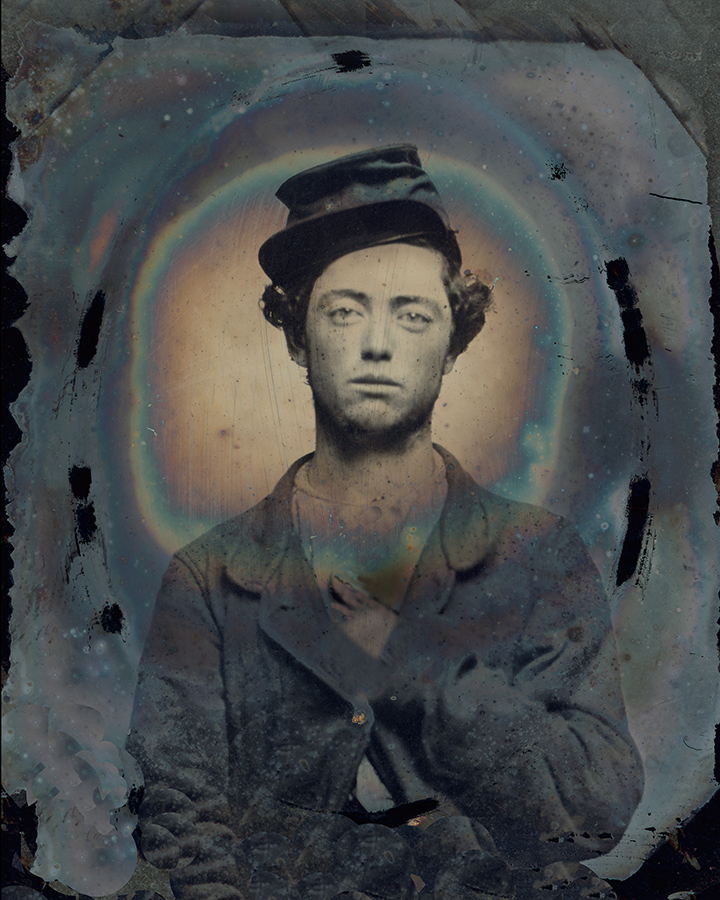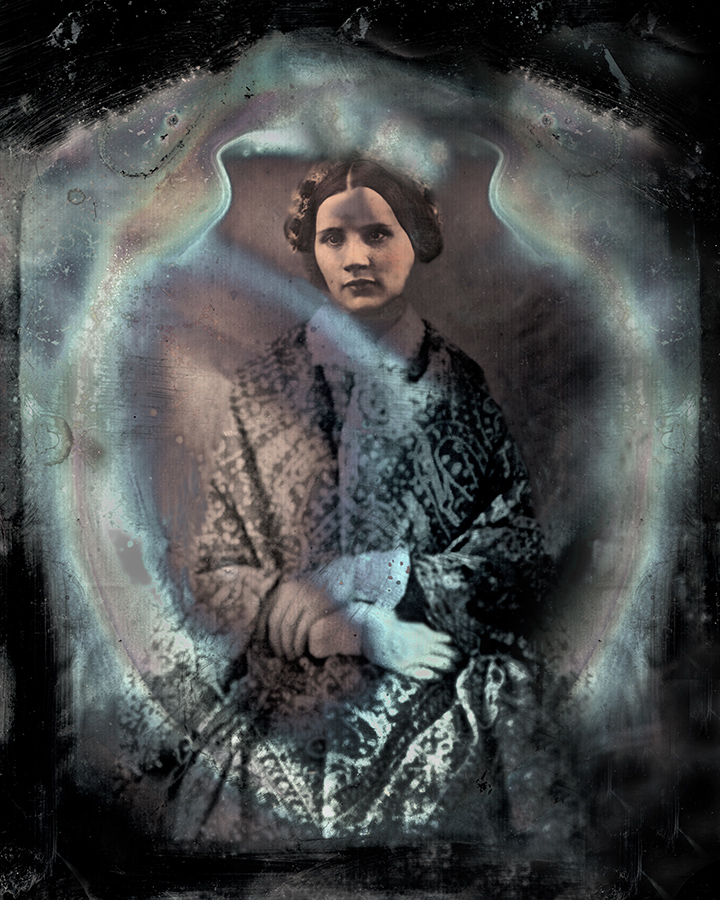Catamount Arts of St. Johnsbury is pleased to present Ghosts: Civil War Portraits, by William Betcher, in the arts center’s Rankin Gallery on Eastern Avenue. The exhibition will run from March 20th through June 4th. An artists’ reception to celebrate this and the Fried Family Gallery exhibtion is scheduled for April 15th.
Inspired by a lifelong fascination with antique portraits of boys in uniform, “Ghosts: Civil War Portraits” reanimates daguerreotypes, ambrotypes, and tintypes of soldiers and women using modern technology. After scanning 19th century plates and printing them on transparent media, artist William Betcher applies light to project a three-dimensional shadow or ghost on the wall behind each piece. From these historic relics, treasured mementos from a time when photography was precious, rare, and, in many cases, the solitary preservation of a person’s likeness, Betcher prompts a reexamination of what was captured by the old technology and what is released by the new.
“Many of these images were made at soldiers’ campsites,” Betcher writes of the project, “when they did not know if they would live to return home.” Betcher points out that women also appear in the portraits, having “also experienced war, devastated by loss…and related malnutrition and epidemics.”
William Betcher is a photographer, writer, and psychiatrist educated at Johns Hopkins, Boston University, Harvard Medical School, and Vermont College of Fine Arts. His work has been exhibited at the Griffin Museum, Catamount Arts, the Danforth Art Museum, Soho Photo Gallery, PhotoPlace Gallery, Massachusetts General Hospital, Dartmouth Hitchcock Medical Center, Mass Audubon Habitat, the University of New England, and other places. He published a book of landscape photography, “Anthem: For a Warm Little Pond,” which was included in the Griffin Museum’s Photobook exhibition in 2016, and he is the author of four nonfiction books. Betcher is the photography editor for Solstice Literary Magazine.
To learn more about William Betcher’s work, visit www.williambetcherphotography.com.
Artist’s Statement
Ghosts: Civil War Portraits is an ongoing investigation of iconic representations of war using daguerreotypes, ambrotypes, and tintypes of soldiers and women of that historical period. Consider that probably only one likeness of each of them was ever made – a special possession displayed on a mantle and held in a family’s hands. In this respect, image making was so different than in our own virtual, digital times. In my work I seek to recreate the photograph as object – its one-of-a-kind materiality, its physical presence.
For many years I have been drawn to antique portraits of boys in uniform, holding muskets, most with their “game face” on, surrounded by ornate copper mattes and gutta-percha cases. Many of these images were made at soldiers’ campsites when they did not know if they would live to return home.
While only a small number of women secretly enlisted as soldiers in the 1860’s, women broadly have also experienced war, as can be seen in their portraits, wearing mourning clothes, devastated by loss, not to mention their own early deaths from childbirth and war related malnutrition and epidemics.
These classic memorial images tell one story, but when I take the small, antique plates out of their cases, behind the mattes is a haunting “backstage” – one of vivid, oxidized decay that suggests other stories. As a psychiatrist, I am drawn to people’s backstories, otherwise known as the Unconscious, as well as how they mourn, for better and for worse.
About ten years ago, on the Washington Post website, “Faces of the Fallen,” I viewed photographic images of soldiers killed in Iraq and Afghanistan and was struck by how little had changed since 1865. I spoke with two of these boys’ families, who said their greatest fear was that their twenty-year-old sons would be forgotten. I felt moved to find ways to breathe new life into war related portraiture.
In the Ghosts series, I scan 19th century plates, work with them digitally, then print them on a 24”x30”, transparent medium which is mounted on acrylic. When light from the front passes through them, a three-dimensional shadow or “ghost” is projected on the wall behind. I like to think that this object is reminiscent of glass ambrotypes and that it evokes what may have been felt in the 1860’s when photographic portraits were so new as to be curiosities – perhaps a sense of the uncanny, of magic, when so many young deaths led the grieving to seek loved ones through séances and spirit photographs.
I have four other related series based on war artifacts that illustrate trauma, grieving, and how boys prepare for war. These include War Games – 24”x36” dye sublimated aluminum portraits of damaged, as-found, WW1 metal toy soldiers, and half-plate tintypes that I have created of these same toys and placed in vintage memorial cases. My series of as-found G.I. Joes, broken in rough play, is titled Brand of Brothers. Inherent in these images are both the boys who played with and damaged these toys and the men that they later became.
The fourth series, War Comics, are enlarged WWII and Korean War comic book covers, juxtaposed with the ads inside that speak to adolescent fantasies and fears.
William Betcher



